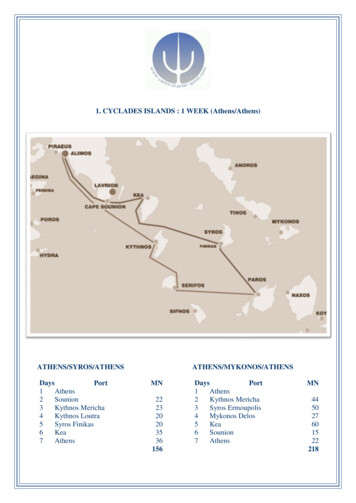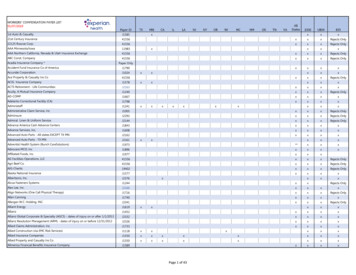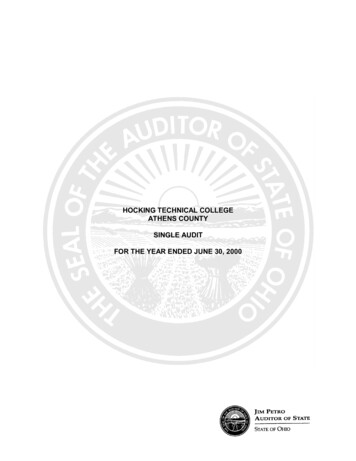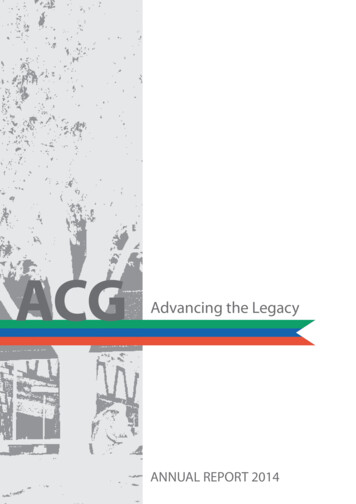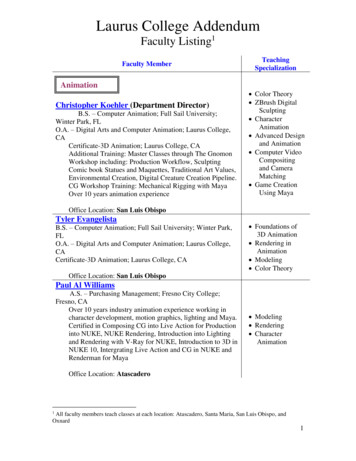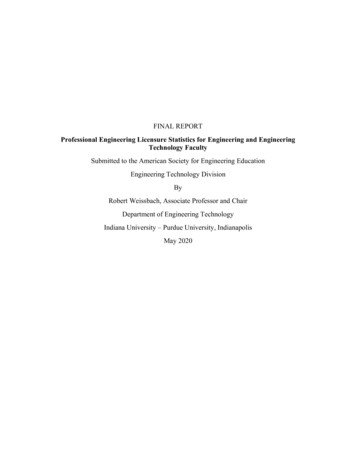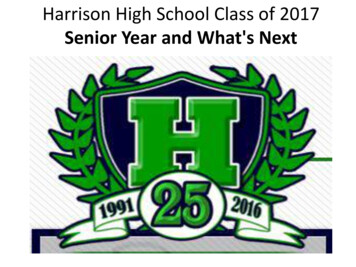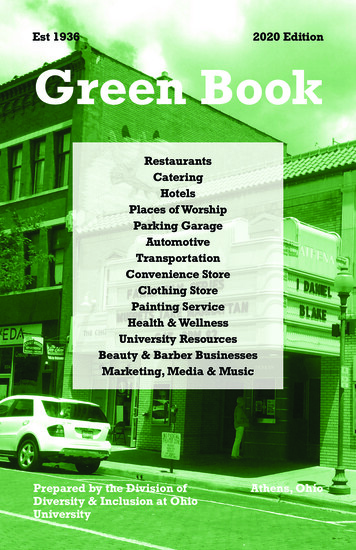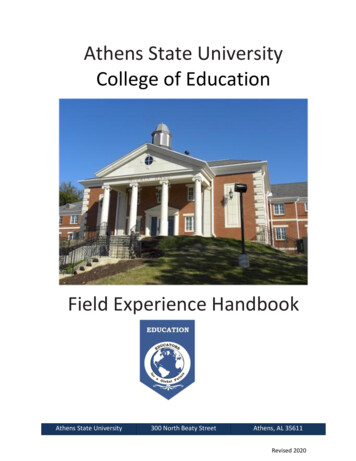
Transcription
Athens State UniversityCollege of EducationField Experience HandbookAthens State University300 North Beaty StreetAthens, AL 35611Revised 2020
Dear Clinical Faculty,The College of Education at Athens State University isdelighted to have you join us in preparing our candidates tomake a positive difference in the lives of students. Yourexpertise in teaching and learning will provide a myriad ofopportunities for our candidates to bridge the gap betweentheory and practice. Please engage the candidate assigned toyou in a wide range of responsibilities.The Conceptual Framework, consisting of the theme,“Preparation of the Reflective Practitioner,” and the purposes, outcomes, and professionaldispositions, acquaints candidates with behaviors necessary for the teaching profession.Candidates are required to provide evidence that the components are adhered to throughout theirprograms of study. Please become familiar with the Conceptual Framework and provideopportunities for your candidate to put them into practice.For many years, your school has graciously accepted ASU teacher candidates for fieldexperiences. Many valuable lessons have been learned. Field placement involves providing a blockof time for candidates to work in a school setting under the guidance of a clinical faculty memberand an Athens State faculty member. We are excited about this venture and are delighted to haveyou assist us.Thank you for helping us prepare those who will touch the future.Sincerely,Faculty and StaffAthens State University2
Athens State UniversityCollege of EducationField Experience HandbookTable of ContentsConceptual Framework . 4Field Experience Overview . 6Requirements . 7General Procedures . 8COE Observation Form . 11Verification Form. 14Field Experience and Internship Office(256) 216-6620field.experience@athens.eduCollege of Education/ Teacher Education Services / Field Experience Link /3
Conceptual FrameworkCollege of EducationPreparation of the Reflective PractitionerAthens State University, College of Education’s (COE) missionis to prepare teacher candidates to be reflective practitionerswho are knowledgeable, collaborative professionals. Theywill have a rich knowledge of content with an understandingof how people learn in various ways combined with theability to apply that knowledge to assure student success.GoalsThe College of Education educates pre-service teachers who embrace student-centered learning,maintain a comprehensive knowledge of content knowledge, possess an excellent foundation ofprofessional and pedagogical knowledge, and model social justice through social responsibility. Ourgraduates are able to do this through adherence to institutional, state, and national standards thatsupport the conceptual frameworkStudent-Centered LearningTo nurture meaningful learning, our candidates must understand the importance of a studentcentered philosophy to learning. They must know how learners are diverse and grow and developdifferently as well as embrace the learning that comes from experience. They must recognize thatpatterns of learning and development vary individually in the context of culture and place andwithin and across the cognitive, linguistic, social, emotional, and physical areas. Our candidatesmust be able to design and implement developmentally appropriate and challenging learningexperiences that motivate diverse children and adolescents representing a range of abilitiesDisciplinary KnowledgeKnowledge of the discipline includes a broad general foundation in the arts and sciences as well asdepth of knowledge appropriate for expertise in a specific field. Knowledge of the discipline isessential for our candidates as they make appropriate pedagogical decisions for diverse groups oflearners, for using technological applications to support learning, and for tapping into bothcognitive and emotional intelligences of the learner.Professional KnowledgeTo ensure excellence in professional knowledge, our students use the central concepts, tools ofinquiry, and structures of the discipline that he/she teaches. Our candidates can create learningexperiences that make the discipline accessible and meaningful to ensure students’ mastery of thecontent (INTASC 4). Our candidates understand how to connect concepts and use differingperspectives to engage learners in critical thinking, creativity, and collaborative problem solvingrelated to authentic local and global issues.4
Pedagogical KnowledgePractical educators who are theory-based understand that their students need a chance toexperiment, work with projects, engage in problem-based learning, and participate in opportunitiesto discover and explore, and then to refine their thinking based on their experimentation.Socially Responsible CitizensAs reflective practitioners our graduates will use interpretive, normative, and critical perspectives inunderstanding the relationship between school and society as well as address emerging issues ineducation. They will exhibit social responsibility through facilitating opportunities to engage inteamwork and cooperation; to study civic liberties and participate in citizenship; to ponder ethicalquestions; and teach a democratic life (Rothstein & Jacobsen, 2009). Our teacher candidates arecommitted to educating diverse communities and responding to experiences as socially responsiblecitizens.Professional DispositionsDispositions reflect the values, commitments, and professional ethics that influence behaviors towardstudents, families, colleagues, and communities. Dispositions are guided by beliefs and attitudesthat affect student learning, motivation, and the candidate’s own professional growth.Throughout a professional program exemplary candidates for the teaching profession should: participate in positive interactions,show respect for self and others,assume responsibility,exhibit interest in the learner and the learning process,exhibit stewardship of diversity,advocate use of technology, andexhibit fairness and the belief that all students can learn.5
Field ExperienceA central component of all teacher education programs at Athens State is the provision of quality fieldexperiences. Field experiences are defined as the formal, required school and community activities withinthe teacher preparation program. These experiences broaden the teacher candidate’s understanding ofeffective classroom instruction and establish a platform for the transfer of theory and translation of researchinto practice.Field experiences are designed to provide teacher candidates with opportunities to view the entire scope ofteaching in a classroom setting and to develop skills and self-confidence necessary to be effective teachers.With this goal in mind, field experiences begin with observations and build gradually to full responsibility as astudent teacher under the close supervision of expert teachers and university supervisors. In the context ofactual classrooms, experienced professionals from schools in our field network help prepare candidates to bereflective practitioners. These carefully planned field experiences are woven into every aspect of the teachereducation program.Throughout the teacher education program, field experiences are connected to specific courses. Thesecourses will integrate assignments (known as Critical Assignments) that align with state standards andprepare teacher candidates to become proficient educators. As part of the course, faculty will teachand model the tasks required; during field experience, teacher candidates will perform the tasks aspart of the course completion. Successful completion of all four critical assignments prepares teachercandidates for the expectations that accompany the culminating clinical practice of Internship.The following levels of field experience are incorporated throughout each program of study:Introductory Level I Critical Assignment 1Early field experiences provide pre-service teachers with diverse opportunities to observe and interact withstudents in surrounding school districts. These placements constitute between 21 and 49 hours minimum of fieldexperience (see program specific Overview Chart). Critical Assignment 1 is embedded in the specific courses,modeled in the field, and assesses the context of learners.Intermediate Level II Critical Assignments 2 & 3These field experiences build on earlier field experiences and situate candidates in the role ofa classroom teacher. These experiences include planning instruction, peer teaching and evaluation, smallgroup and/or whole class teaching, assisting clinical faculty, and case studies. These placements constitute 70hours minimum of field experience (see program specific Overview Chart). Both Critical Assignments 2 & 3 areembedded in the specific courses, are modeled in the field, and assess teaching & instruction, as well as,learning analysis.Intermediate Level III – Critical Assignment 4These field experiences continue to build on earlier field experiences and situate candidates inthe role of a classroom teacher. University faculty will accompany small groups of candidates.These experiences include peer teaching and evaluation, small group and/or whole class teaching, assistingclinical faculty, case studies, and instruction analysis. These placements constitute 35 to 70 hours of fieldexperience (see program specific Overview Chart). Critical Assignment 4 is embedded in the specific courses, ismodeled in the field, and assesses teaching & instruction, as well as, learning analysis.6
Field Experience RequirementsABI/FBI Fingerprinting Background Clearance:Candidates seeking a degree that leads tocertification in a College of Education program, or in a College of Arts and Sciences program with a minor inEducation are required to complete an ABI/FBI Background Clearance upon admission to ASU and prior toapplying for Field Experience.Read More at: kground-clearance/Tuberculosis (TB) Skin Test:Candidates seeking a degree that leads to certification in a College ofEducation program, or in a College of Arts and Sciences program with a minor in Education are required tosubmit a current negative tuberculosis skin (TB) test to the Teacher Education Department upon admissionto ASU. (Negative TB Skin tests are current for 3 years effective from the date read.)Read More at: tb-skin-test-information/LiveText:LiveText is an online web-based learning assessment. Candidates seeking a degree that leads tocertification in a College of Education program, or in a College of Arts and Sciences program with a minor inEducation are required to purchase LiveText. Teach for America students, Provisional Certification studentsand recertification/ renewal students are not required to purchase LiveText.Enrollment in Courses:Candidates seeking a degree that leads to certification in a College of Educationprogram, or in a College of Arts and Sciences program with a minor in Education are required to be enrolledin courses during the semester in which field experience placements are completed. The Overview Chartshown below indicates courses that currently require Field Experience days.Field Experience OverviewPROGRAMContext ofLearnersLesson PlanTeach/VideoLessonOther AssignmentED359/5daysTeach/Video 2Lessons*Instructor Led*AR455/5daysArtED302/3daysAR454/4daysEarly m/CollabED302/3daysEL321/5daysHealth & daysHPE430/5daysSE301/4days(during Semester 1)SE301/4days(during Semester 1)SE301/4days(during Semester 01/10daysCollab K-6Collab --SE301/4days(during Semester 1)Must apply online for FE placement each semester enrolled in one of the courses listed above; based on your major. (ASU Online / Student Tab)ED302 students must have TB test and FBI fingerprint clearance on file prior to being able to apply; no later than week 3 of the semester enrolled.Must submit Verification Form prior to semester exams to receive credit for FE days. Submit through Blackboard / FE Organization submission link.*Instructor Led school preferences will be assigned in/near an Athens State approved site.7
General ProceduresApplicationAn online Field Experience Application must be submitted to the Field Experience Office each semester inwhich the candidate is requesting placement for field experience. Go To ASU Online. Enter Username andPassword. Go To Student Tab / College of Education Field Experience Application. Select the Term. Selectschool preferences. Confirm the course you are enrolled in. Click Continue. Review your application.Submit. NOTE: Specific schools are assigned during Summer semesters & Instructor Led courses.Application DatesGo To nce-announcementsPlacementCandidates are placed under the instruction, supervision, and assessment of P-12 school and highereducation clinical faculty with exceptional experience as noted & assigned by the LEA’s representative.Required field experience consists of a minimum of 154 clock hours (22 days) prior to internship. Themajority of field experiences must occur in P-12 schools, span all of the grades for which certification issought and at least half of the field experiences must be in the candidate’s teaching field. To view yourplacement, return to the application site.Field Experience placements are made based on the following information: Candidate’s major (See chart below.) Candidate’s address Candidate’s school system requestso On-the-job field experience requests must be approved by the Director of Clinical Experiences and be in theappropriate area of certification with specific assessmentsLocation and diversity settings of previous field experience assignment(s)Professor site recommendations, including Professional Development Schools (partnerships)Every effort is made for field experience and internship to include the opening and closing of a school year.However, it is necessary to work within the academic calendars of the public school and Athens State.Field experience and internship placements are completed prior to exam week for each academic semester.MajorEarly ChildhoodElementaryElementary/Collaborative K-6Health & Physical EducationPhysical EducationPlacement GuidelineGrade PlacementGrades P-3 – Two PlacementsChildcare centers or homes/Head Start/ P3 (2of3)Grades K-6 – Two PlacementsUpper Grade Range & Lower Grade RangeGrades K-6 – Two PlacementsELE Setting & Collaborative SettingGrades 6-10 / Grades P-12 – Two PlacementsHealth Education Setting & PE Setting (ELE or MS/HS)Grades P-12 – Two SettingsELE Setting & MS/HS Setting8
Art EducationArts & Science Lic and CertSpecial EducationCollaborative K-6Special EducationCollaborative 6-12Grades P-12 – Two SettingsELE Setting & MS/HS SettingGrades 6-12- One PlacementContent area must match with the majorGrades K-6 – Two PlacementsLower Grade Range & Upper Grade RangeGrades 6-12 – One PlacementCollaborative SettingDiversityCandidates will be placed in varying diverse settings throughout the with clinical faculty based onprincipal recommendation; clinical faculty are P-12, three years of teaching experience and/or holdsa Master’s Degree.Diversity CodeMINBDescription of CodeLow Minority PopulationBLNDBlended PopulationMINAHigh Minority PopulationDUALSINGURBANRURALPRIVATELREDDual Gender SchoolSingle Gender SchoolCity school systemCounty school systemPrivate schoolLow Racial/Ethnicity DiversityLevelMiddle Racial/Ethnicity DiversityLevelHigh Racial/Ethnicity DiversityLevelMREDHRED% Percentages1/3 or less minority population under 33%1/3 - 2/3 minority population 34-67%2/3 or more minority population 68-100%68%-100%34% - 67%0 – 33%Professionalism Candidates should be polite when calling schools to schedule their days. Find out what time schoolbegins and where to park.Candidates are required to wear their ASU ID badge at all times during field experience placements.Badges are obtained through the Athens State University Security Office Location: ASU Campus Security Hours 8:00 – 4:00 PM Information: 256-233-8222Sign in at the front office immediately upon entering the school each day. Candidates are alsorequired to sign out at the end of each day.Dress and act in a professional manner.Arrive promptly. Be on time or early.9
Exhibit a positive, courteous attitude. (Field Experience students are guests in the school.)Abide by all school rules. (especially those dealing with food, beverages, and cell phones)Be positive, refrain from any negative comments, derogatory remarks or comments toward or aboutthe school, its personnel, or its students either verbally or nonverbally (such as Facebook).Candidates are to contact the school office and classroom teacher immediately if they must miss ascheduled day.Check Athens State email regularly during Field Experience. (This is a MUST! Important information isoften sent during the 2 week course release timeframe.)Instructor Led Field ExperiencesSmall groups of candidates accompanied by an Athens State instructor will conduct field experiences indesignated Professional Development Schools (PDS). These PDS sites are innovative partnership formedbetween Athens State and P-12 schools. Candidates will be required to travel in/near the Athens area tocomplete these special field experiences.Field Experience AssessmentsAll Athens State candidate field experience placements require the completion of the professionaldispositions assessment in LiveText by the hosting classroom teacher.Faculty leading field experiences will be required to complete two online LiveText assessments:(1) Professional Dispositions Assessment and (2) COE Observation Form (see Rubric pg11).Verification Forms – credit for field experience completionTo earn credit for completion of field experience, you must upload a completed Field Experience VerificationForm (see Form pg prior to exams week of the semester you conducted your field experience. to thefollowing locations:(1) SUBMIT to the Field Experience Office using the Blackboard/FE Organization/Submission Link.(2) UPLOAD to your Education Course container.(3) SAVE in your LiveText/Watermark account for future reference.10
UnacceptableTargetTeacherCandidate:AcceptableCOE Formal ObservationI. LessonImplementationPreparednessInTasc Std 7210All lesson materials areLesson materials areAvailability andreadily available and aresomewhat available andpreparedness for theappropriate for theare somewhat specific tolesson based on thespecific lesson based onthe lesson based on thecontext for learning wasthe context for learning.context for learning.not evident.Questioning/PromptsUtilizes open-endedUtilizes open-endedUtilization of open-endedInTasc Std 7, 8questions that elicitsquestions that elicitsquestions that elicitsdetailed, individualizedwhole/small groupresponses throughresponses throughresponses throughprompts & questioningprompts & questioning.prompts & questioning.was not evident.Critical ThinkingUtilizes a high level ofUtilizes a moderate levelUtilization of criticalInTasc Std 7, 8critical thinking, problemof critical thinking,thinking, problem solving,solving, analysis,problem solving, analysis,analysis, creativity &creativity & other skills.creativity & other skills.other skills was notevident.Prior KnowledgeHighly effective atModerately effective atCapturing students’InTasc Std 5, 7, 8capturing students’capturing students’interest and activatinginterest and activatinginterest and activatingprior knowledge needed toprior knowledge needed prior knowledge needed to build on the lesson & toto build on the lesson &build on the lesson & to motivate students to learnto motivate students to motivate students to learn.was not evident.learn.Stimulating Interest Utilizes multiple varieties Utilizes a few strategiesUtilization of strategiesInTasc Std 5, 7, 8of strategies that elicit a that elicit a moderate levelthat elicits effectivehigh level of studentof student engagement &student engagementengagement &participation.and/or participation wasparticipation.not evident.CommunicationUtilizes proper oral &Utilizes oral & writtenUtilization of oral &InTasc Std 3, 8, 10written communicationcommunication thatwritten communicationthat promotes a high level promotes a moderate level that promotes effectiveof communication withof communication withcommunication with thethe learners.the learners.learners was not evident.PlannedImplements all plannedImplements a minimalImplementation ofSupports/Scaffoldinsupports and/orlevel of planned supportsplanned supports and/orgscaffolding defined in the and/or scaffolding definedscaffolding during theInTasc Std 1, 2, 7, 8 lesson plan in an effort toin the lesson plan in anlesson was not evident.support diverse learners.effort to support diverselearners.Lesson PaceInTasc Std 3, 7 8Utilized the allotted timeeffectively with alllearners engaged &participating throughoutthe lesson.Academic Language Utilizes multiple/variedInTasc Std 3, 4, 5academic languagedemands which supportthe lesson content.Formative/SummatiUtilizes multipleve Assessmentsformative and/orInTasc Std 6, 7, 8- summative assessments to10inform teaching practices& provide studentfeedback.Specific feedbackUtilizes feedback whichInTasc Std 4, 5, 6is specific and related tothe lesson objectives.Utilized the allotted timewith learners engaged &participating throughoutmost of the lesson.Grade/Subject:Date:CommentsUtilization of the allottedtime was minimal,resulting in gaps in thelearning.Utilizes academicUtilization of academiclanguage demands which language demands whichminimally support thesupports the lessonlesson content.content was not evident.Utilizes minimal (one)Utilization offormative and/orformative/summativesummative assessment to assessments is not used toinform teaching practices inform teaching practices& provide studentor to provide studentfeedback.feedback.Utilizes feedback which is Utilization of feedbacksomewhat general and/orrelated to the lessonnot related to the lessonobjectives is not evident.objectives.11
II. ManagementBehaviorsInTasc Std 32Provides an environmentwith a high level ofrespect throughreinforcement andpositive interactions.ProblemInterventionInTasc Std 3Demonstrates the ability Demonstrates the abilityto effectively monitorto minimally monitorclassroom managementand/or intervene whenissues & intervenes when classroom managementappropriate.issues occur.Provides an environment Provides an environmentwith a high level ofwith a minimal level ofunderstanding &understanding &appreciation for rules &appreciation for rules &procedures for anprocedures for aneffective learningeffective learningenvironment.environment.Demonstrates a high level Demonstrates a minimalof rapport,level of rapport,encouragement, andencouragement, andengagement with allengagement with alllearners.learners.Acknowledges studentAcknowledges studentresponses through the use responses through the useof respectful, positive, &of phrases that consistspecific phrases.mostly of “Good Job”.Communitycohesion.InTasc Std 3Student RapportInTasc Std 3AcknowledgingStudent ResponsesInTasc Std 3ClassroomDemonstrates the abilityConditionsto effectively monitor &(i.e. horseplay,respond to unsafeinappropriate use ofclassroom conditions.classroom materials,bullying, etc.)InTasc Std 3III. Differentiation2Diverse LearnerUtilizes appropriateMaterialsmaterials that effectivelyInTasc Std 1, 2differentiate instruction tomeet the needs of alllearners.InstructionalUtilizes multiple andStrategiesvaried instructionalInTasc Std 1, 2, 6,strategies resulting in a7, 8high level of engagement& student interaction byall learners.TechnologyUtilizes multiple/variedInTasc Std 3, 4-5,technology resulting in a8, 9high level of studentengagement & reflectivepractices.IV. Content2Content KnowledgeDemonstrates a strong(e.g. genre, sets)understanding of specificInTasc Std 4, 5content knowledgethroughout the lesson.ContentDemonstrates a high levelcomparisons &of varied examples andexamplesillustrations to linkInTasc Std 4, 5specific content to studentexperiences.AssignmentDemonstrates in-depthProceduresknowledge of specificInTasc Std 4, 5content in order to carryout all procedures of thelesson.1Provides an environmentwith a minimal level ofrespect throughreinforcement and/orpositive interactions.Demonstrates the abilityto minimally monitor &respond to unsafeclassroom conditions.0An environmentdemonstrating respectthrough reinforcementand/or positiveinteractions was notevident.Allows disruptive studentbehavior(s) to interferewith the learning process.CommentsAn environmentdemonstrating theunderstanding &appreciation for rules &procedures was notevident.Rapport, encouragement,and engagement with alllearners were not evident.Acknowledgement ofstudent responses throughthe appropriate use ofrespectful, positive, &specific phrases was notevident.Ability to appropriatelymonitor & respond tounsafe classroomconditions was notevident.10Utilizes materials thatUtilization of materialsdifferentiate instruction tothat differentiatemeet the needs of most instruction for the learnerslearners.was not clearly evident.Utilizes minimalUtilization of variedinstructional strategiesinstructional strategiesresulting in a minimalwas not evident.level of studentengagement &interaction(s).Utilizes technologyUtilization of technologyresulting in a minimalresulting in studentlevel of studentengagement & reflectiveengagement & reflective practices was not evident.practices.10Demonstrates a minimalUnderstanding and/orunderstanding of specificdelivery of specificcontent knowledgecontent knowledge wasthroughout the lesson.inadequate.Demonstrates a minimalUtilization of variedlevel of varied examplesexamples or illustrationsor illustrations to linkto link specific content tospecific content to student student experiences wasexperiences.not evident.Demonstrates generalizedKnowledge of specificknowledge of specificcontent needed to carrycontent in order to carryout the procedures of theout procedures of thelesson was not evident.lesson.CommentsComments12
Displays ability toidentify, understandand analyze errorsin student learningInTasc Std 4, 5ContentConnectionsInTasc Std 4, 5Demonstrates a strongability to effectivelyidentify, understand andanalyze misconceptionsand/or errors in studentlearning.Demonstrates a minimalability to identify,understand and analyzemisconceptions and/orerrors in student learning.Ability to identify,understand and analyzemisconceptions and/orerrors in student learningwas not evident.Demonstrates ability toDemonstrates ability toAbility to makemake in-depth, authenticmake generalizedconnections to the contentconnections to the content connections to the contentknowledge was notknowledge in multipleknowledge.evident.ways.Total Score13
FIELD EXPERIENCE VERIFICATION FORM(1) SUBMIT to the Field Experience Office prior to exam week using the Blackboard/FE Organization/Submission Link.(2) UPLOAD to your Education Course container.(3) SAVE in your LiveText/Watermark account for future reference.STUDENT INFORMATIONNAME STUDENT ID NUMBEREMAIL PHONEMAJOR TERM NUMBER OF COMPLETED FE DAYSCOURSE INFORMATION (Provide course(s) that require field experience)Course CRNCourse CodeSchool System(s)Title of CourseSchool(s)Grade/SubjectCooperating TeacherNote: The signature of the cooperating teacher(s) verifies the student completed the required amount of time in theclassroom. Fall and Spring Semesters: Each day assigned equals 7 hours, for example, 8:00 a.m. – 3:00 p.m.DateTime InTime OutTeacher’s Signature14
Field Experience Handbook Athens State University 300 North Beaty Street Athens, AL 35611 Revised 2020. 2 Dear Clinical Faculty, The College of Education at Athens State University is . Must apply online for FE placement each semester enrolled in one of the courses listed above; based on your major. (ASU Online / Student Tab)
